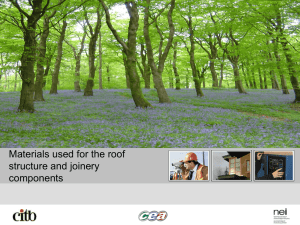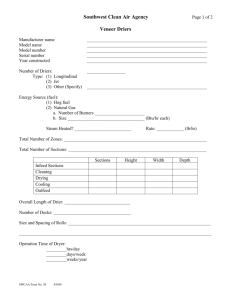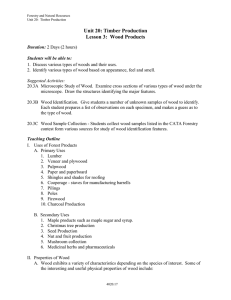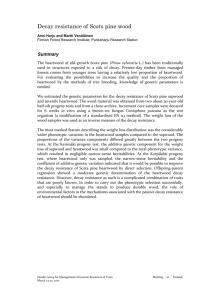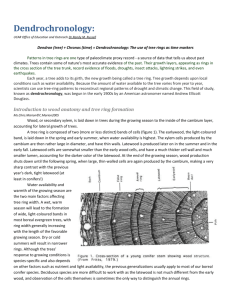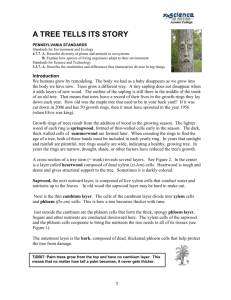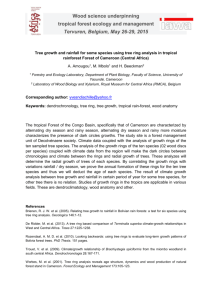Chapter Two (pg
advertisement
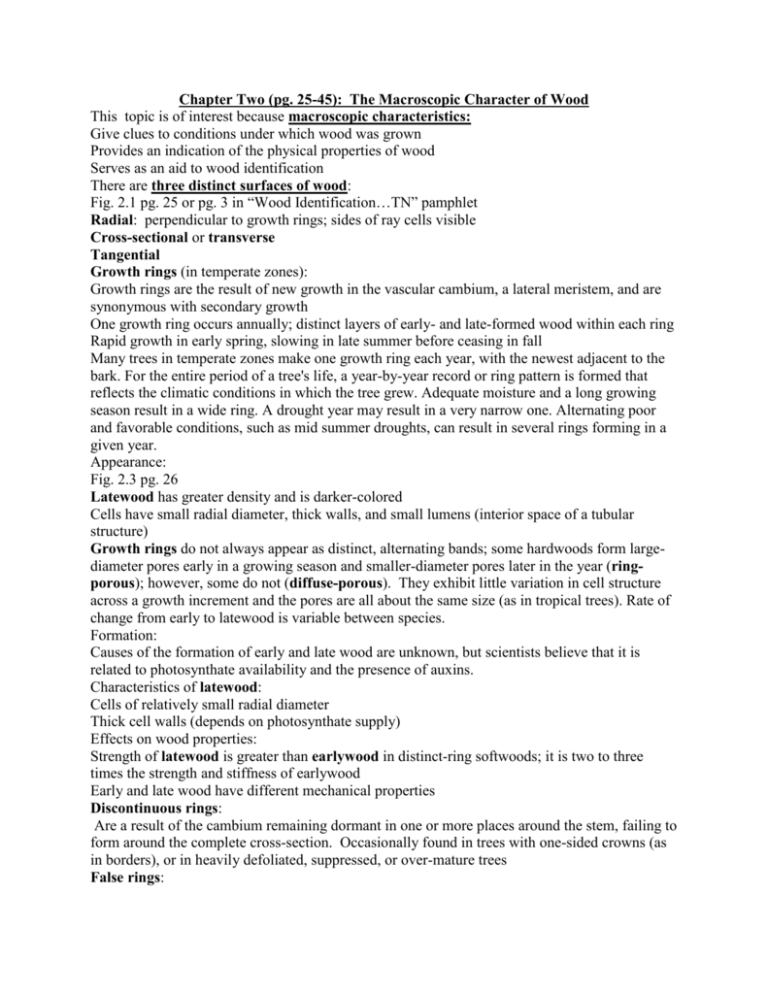
Chapter Two (pg. 25-45): The Macroscopic Character of Wood This topic is of interest because macroscopic characteristics: Give clues to conditions under which wood was grown Provides an indication of the physical properties of wood Serves as an aid to wood identification There are three distinct surfaces of wood: Fig. 2.1 pg. 25 or pg. 3 in “Wood Identification…TN” pamphlet Radial: perpendicular to growth rings; sides of ray cells visible Cross-sectional or transverse Tangential Growth rings (in temperate zones): Growth rings are the result of new growth in the vascular cambium, a lateral meristem, and are synonymous with secondary growth One growth ring occurs annually; distinct layers of early- and late-formed wood within each ring Rapid growth in early spring, slowing in late summer before ceasing in fall Many trees in temperate zones make one growth ring each year, with the newest adjacent to the bark. For the entire period of a tree's life, a year-by-year record or ring pattern is formed that reflects the climatic conditions in which the tree grew. Adequate moisture and a long growing season result in a wide ring. A drought year may result in a very narrow one. Alternating poor and favorable conditions, such as mid summer droughts, can result in several rings forming in a given year. Appearance: Fig. 2.3 pg. 26 Latewood has greater density and is darker-colored Cells have small radial diameter, thick walls, and small lumens (interior space of a tubular structure) Growth rings do not always appear as distinct, alternating bands; some hardwoods form largediameter pores early in a growing season and smaller-diameter pores later in the year (ringporous); however, some do not (diffuse-porous). They exhibit little variation in cell structure across a growth increment and the pores are all about the same size (as in tropical trees). Rate of change from early to latewood is variable between species. Formation: Causes of the formation of early and late wood are unknown, but scientists believe that it is related to photosynthate availability and the presence of auxins. Characteristics of latewood: Cells of relatively small radial diameter Thick cell walls (depends on photosynthate supply) Effects on wood properties: Strength of latewood is greater than earlywood in distinct-ring softwoods; it is two to three times the strength and stiffness of earlywood Early and late wood have different mechanical properties Discontinuous rings: Are a result of the cambium remaining dormant in one or more places around the stem, failing to form around the complete cross-section. Occasionally found in trees with one-sided crowns (as in borders), or in heavily defoliated, suppressed, or over-mature trees False rings: Duplicate rings created by events such as drought, late frost, or defoliation, that cause terminal growth to slow or cease, reducing auxin production, within a season that are followed by favorable growth conditions Exhibit a gradual change in cell character on both sides of the false latewood, resulting in double gradation; whereas, normal growth rings are characterized by an abrupt change in cell size and wall thickness from the last-formed latewood of one seasonal ring to the earlywood of the next Heartwood and sapwood: Fig. 2.8 pg. 31 A stem cross-section shows a dark-colored center portion (heartwood) surrounded by a lightercolored outer region (sapwood); sometimes there is not a color difference Heartwood: Made up of dead cells Usually begins to form around age 14-18 Heavier, stronger, more highly figured, more resistant to decay Factors in formation: Age Distance from cambium Other unknown factors Suspected factors: Accumulation of carbon dioxide or ethylene gas Reduction of moisture content levels and/or cessation of water transport in the inner regions of the stem Enzyme activity Gradual reduction of starch, sugars, or lipid reserves from the cambium inwards and formation of compounds known as extractives, which are chemical components that give heartwood its distinctive properties and can be extracted from the heartwood Extractives or secondary metabolites (formation of which accompanies death of cells): are substances that do not participate directly in tree growth and development formed from transported metabolites (products of physical and chemical processes associated with the maintenance of life) by living parenchyma cells at the heartwood boundary (pg. 34) Accumulate in cell walls and lumens Usually polyphenolic in nature a group of chemical substances found in plants, characterized by the presence of more than one phenol unit or building block per molecule polyphenols that are commonly associated with heartwood include: oils, resins, gums, tannins, and aromatic and coloring materials other compounds in heartwood include fats and waxes (pg. 34) Embolism: an obstruction caused by the formation of air bubbles as liquid pressure is reduced (water columns in xylem are under tension); more likely to occur as height from the ground increases Properties of Heartwood: Darker color (Black walnut is valued for this) Highly decay- or insect-resistant or both Cedar and Cypress have highly resistant heartwood Difficult to penetrate with liquids Not as penetrable by chemical treatments Difficult to dry Odor Slightly higher weight-per-unit volume No difference in strength except maybe to being crushed (pg. 37) Rays: Provide an avenue by which sap can travel horizontally either to or from the phloem layer; extend from the cambium toward the pith Produced by division of ray initials in the cambium A ray is a collection of cells Grain orientation: The direction of most of the long tapered fibers of wood are parallel to the long axis Fig. 2.12 (pg. 41) Spiral grain: in trees in which fibers are spirally arranged about the stem axis caused by anticlinal division (production of new initials by radial partitioning, pg. 14) in which new cambial cell formation occurs in one direction only typically low in strength and stiffness and may tend to twist as it dries fig. 2.13 (pg. 41) Interlocked grain: wood produced when grain spirals in one direction for several years and then reverses direction to spiral oppositely genetically controlled an example is elm the wood is difficult to split, may shrink longitudinally upon drying, and can warp unpredictably, but is sometimes desirable from an appearance standpoint as alternating grain directions cause light to reflect in varying patterns across radially cut wood, giving a “ribbon stripe” figure (as in veneer); fig. 2.14 (pg. 42) Knots: Fig. 2.15 (pg. 43) Branch bases become more and more deeply embedded in the trunk as diameter growth increases Most branches originate from the pith the base of the branch is cone-shaped intergrown or tight knots result from living branches being incorporated into the main stem due to natural growth; these knots do not become loose or fall out upon drying loose or encased knots result when a dead branch is incorporated into the main stem as the cambial layer of the main stem continues to grow over where the branch died; knots formed this way may fall out as the lumber dries Growth rate vs. Wood quality: generally conifers improve strength as growth rate increases. Ring porous hardwoods increase the relative amount of earlywood as growth rate increases, this earlywood is also less dense and strong, resulting in overall decrease in strength and density as growth rate increases. Diffuse porous hardwoods properties are generally not effected by growth rate. Pith is the residue of the apical meristem Dendrochronology is the use of ring growth patterns for age and climate determinations as old as the tree. NRCS data gateway has all aerial maps of US "Macroscopic characteristics are very important for wood ID" Quiz for Chapter Two: The Macroscopic Character of Wood A church is built in Norway using only heartwood. Why not use sapwood? Because sapwood is not rot-resistant. When would you want to use sapwood? If you want to use preservatives or for aesthetic purposes (as with maple sapwood which is white). What is the difference between earlywood and latewood? Earlywood is formed in the spring and cells have larger radial diameters than latewood and thinner cell walls; latewood has greater density and is darker-colored and cells have smaller radial diameters, thick cell walls (depends on photosynthate supply), and small lumens (interior space of a tubular structure). What is the difference between the terms “growth ring” and “annual ring”? An annual ring occurs once during a season (in temperate climates); a growth ring can occur multiple times during the year (as in tropical climates). What are reasons for variations in heartwood and sapwood properties? Heartwood is made up of all dead cells and no longer conducts water; it is a repository for secondary metabolites or substances known as extractives which are characterized by polyphenols such as tannins, gums, odor, etc. Sapwood conducts water, does not have secondary metabolites, contains around 5% living cells, etc. Factors in formation: Age Distance from cambium Other unknown factors

